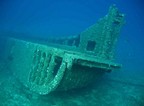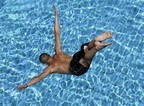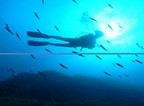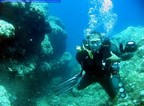- The main reason you dive is to see the beautiful things underwater! Yet many divers look thru a constant fog on their faceplate, seeing very little clearly. Clean your faceplate before you think of going in the water. If it is new, use toothpaste, detergent, etc., until a thin sheet of water forms on the inside of the glass when you wet it, without beading up. Pay special attention to the outside edges of the glass, too. Why buy a wide angle faceplate if you are only going to keep the center of the lens clear.
- Stay aware of your buddy. Keep your buddy in sight and if you do get lost, retrace your track until you find them. If you do not find them immediately, have a signal, like four taps on your tank, repeated several times, meaning “Come to the surface and look for me!” When it is answered, go carefully to the surface and locate the buddy, get together and go down again. When you roll over the side, do not take your own sweet time to adjust your mask, your BC, etc. In a strong current you will end up far behind the boat, requiring a long pull to the stern, hopefully via a trailing line, and then a swim for the anchor line. Instead, be slightly uncomfortable for long enough to get on the anchor line or a descending line, and then adjust everything before going on with the dive. That way you don’t end up all alone, way behind the boat, and use up much of your air or spoil a dive.
- If currents are strong, and it is easy to watch foam, bubbles, or floating Sargassum weed going by to tell you how strong it is, prepare a “chicken line”. Tie a line to the anchor line a few feet UNDER the surface. The best way is to tie it above water, then let out another 10 or so feet of line, to get it down under the dangerous bow. Fasten the bitter end to the after cleat, with a small belly in the line so one can roll over clutching it, then pull down to the anchor line without fighting the current or being hit by the bow of the boat
- Don’t ever put equipment on the rail, gunwale, diving platform, etc. A little roll and it’s over the side. Often a diver brushes it with wet jacket or other equipment and over it goes. Put it inside in a bucket, or along the sides of the hull away from scuppers and openings.
- Touch nothing on the bottom which you do not recognize! Let an experienced diver show you the things to leave along. Wear gloves if possible, contrary to what is taught in dive classes now.
- Generally keep your mask and fins on (and your mouthpiece in your mouth if you have air) while coming aboard. That way, if you slip back in you are still in control, with the mask to keep water out of your nose, and fins to propel you against the current. If you hand your tank in or tie it off to a trailing line, release the mouthpiece as the last thing. Never give up the mouthpiece for a snorkel while you have air in your tank. As long as the regulator works you are in control. Most dive courses teach you to knock the mask down around the neck, instead of putting it up on the forehead, where it can get knocked off and lost.
- Anytime you take off your tank and BC after a dive, put enough air in their BC so it floats if it gets accidentally released.
- If you can devise a place to carry your snorkle besides tied to your mask, you will save a lot of trouble with the snorkle pulling on the mask, and breaking the seal, or hitting you on the side of the head. If you are underweighted and fighting to stay on bottom, pick up a rock and carry it. It sure beats swimming head-down thruout the dive and will save a great deal of air, making the dive longer and more enjoyable. Try and pick a rock with as little growth on it as possible, so as not to kill bottom critters.Note the direction of the current, if any, before you go into the water. Also the direction of travel of the waves because the bottom surge is toward and away from the shore, often at a small angle with the shore. Note the location of the sun in the sky, the orientation of ripple marks, and any other directional clues which will help you return to the boat without a compass. While underwater, note landmarks; rope on the bottom, odd shaped reef masses, distinctive sponges, abandoned lobster pots, white sand runs, usually east – west trending, which will tell you where you are as you return to the boat.
For more info on scuba-diving in Greece, click here



